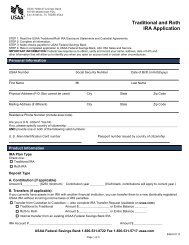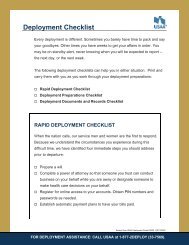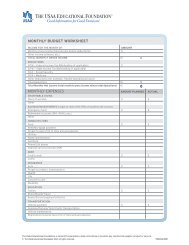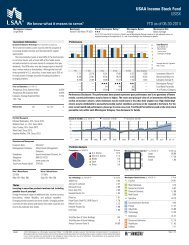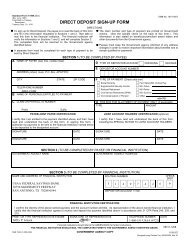Prospectus - USAA
Prospectus - USAA
Prospectus - USAA
You also want an ePaper? Increase the reach of your titles
YUMPU automatically turns print PDFs into web optimized ePapers that Google loves.
the date of issue. The period of “call protection” may be longer or shorter<br />
than 10 years, but regardless, bonds purchased closest to the date of issue<br />
will have the most call protection. Typically, bonds with original maturities<br />
of 10 years or less are not callable.<br />
Although bond prices rise when interest rates drop, falling interest rates<br />
create the environment necessary to “call” the higher-yielding bonds from<br />
your Fund. When bonds are called, a Fund is affected in several ways. Most<br />
likely, we must reinvest the bond-call proceeds at lower interest rates. The<br />
Fund’s income may drop as a result. The Fund also may realize a taxable<br />
capital gain.<br />
Credit Risk: Credit risk is the possibility that an issuer of a fixed-income<br />
instrument will fail to make timely interest and principal payments on its<br />
securities or that negative market perceptions of the issuer’s ability to make such<br />
payments will cause the price of that security to decline. Changes in economic<br />
conditions or other circumstances are more likely to lead to a weakened<br />
capability to make principal and interest payments on these securities than is the<br />
case for higher-rated securities. When evaluating potential investments for a<br />
Fund, our analysts also assess credit risk and its impact on the Fund’s portfolio.<br />
Nevertheless, even investment-grade securities are typically subject to some<br />
credit risk. Securities in the lowest-rated investment-grade category have<br />
speculative characteristics. In addition, the ratings of securities are estimates by<br />
the rating agencies of the credit quality of the securities and may not take into<br />
account every risk related to whether interest or principal will be repaid on a<br />
timely basis. Lower credit ratings correspond to higher credit risk and higher<br />
credit ratings correspond to lower perceived credit risk. Credit ratings do not<br />
provide assurance against default or other loss of money. In addition, ratings and<br />
market value may change from time to time, positively or negatively, to reflect<br />
new developments regarding the issuer. If a security has not received a rating, a<br />
Fund must rely entirely upon the Adviser’s credit assessment.<br />
Securities rated below investment grade (junk or high-yield bonds) should be<br />
regarded as speculative, because their issuers are more susceptible to financial<br />
setbacks and recession than more creditworthy companies. If a Fund invests in<br />
securities whose issuers develop unexpected credit problems, the Fund’s NAV<br />
could decline. Changes in economic conditions or other circumstances are more<br />
likely to lead to a weakened capability to make principal and interest payments<br />
on these securities than on higher-rated securities.<br />
Interest Rate Risk: As a mutual fund investing in bonds, each Fund is subject<br />
to the risk that the market value of the bonds in a Fund’s portfolio will fluctuate<br />
because of changes in interest rates, changes in supply and demand for taxexempt<br />
securities, or other market factors. Bond prices are linked to the<br />
25 | <strong>USAA</strong> California Funds



